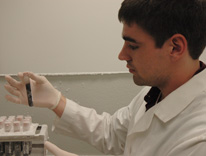
A University of Colorado Cancer Center pilot study has discovered that the quality of dehydrated RNA from human cancer biospecimens compares favorably to those stored in ultra-low-temperature (minus-80 centigrade) freezers.
The study has been directed by Professor William Robinson, MD, PhD, Medical Oncology, in collaboration with David Turnquist, associate vice chancellor, Facilities Management.
The benefits of dry storage include minimizing the hazards of shipping biospecimens - even small temperature fluctuations can compromise frozen samples - and lowering energy costs and greenhouse gas emissions associated with ultra-low temperature freezers, Robinson said. Another advantage is that dry storage removes the risk of a malfunctioning freezer, which can destroy the integrity of samples.
"If you just dry out a tissue sample, the DNA and RNA degrades," Robinson said. "But a couple companies have come up with a means of drying DNA and RNA to maintain their integrity, so you can use the samples for long-term molecular studies."
The study compared RNA obtained from identical melanoma tissue samples - one batch frozen, the other stored at room temperature in a humidity controlled container - held in the Skin Cancer Biorepository. In total, the Research 1 South facility stores in freezers and liquid nitrogen tanks about 5,000 human biospecimens of melanoma and other forms of skin cancer, Robinson said, making it one of the largest biorepositories on the Anschutz Medical Campus.
"The pilot study shows that the RNA and DNA stored dry is as good as that stored in a frozen state," Robinson said. "What that means, if we can reduce the number of freezers, it would be a tremendous cost savings to the university."
Turnquist said most of the research freezers on the Anschutz Medical Campus have an electronic monitoring system that triggers an alarm if power unexpectedly goes off or there is freezer failure. Facilities Management has located spare freezers across the research facilities for temporary use in the event that a freezer malfunctions.
If researchers can store the samples at room temperature on the shelves in their lab, "then Dr. Robinson doesn't have to worry about getting calls at 3 a.m. that the power is out or the freezer isn't working," Turnquist said. "If I can eliminate any freezers, theoretically we can reduce energy costs for the university as well as the greenhouse gases they produce."
Robinson said research shows that a single ultra-low-temperature freezer is, in a year's time, on par with the energy consumption and exhaust production of six vehicles.
He said if dry storage proves consistently effective it would be a great advance in biospecimen research. However, he acknowledges, questions remain, such as:
- At what temperature is it safest to store biospecimens? Room temperature or refrigerated?
- Do different types of cancer tissue, such as breast cancer, get the same results as melanoma samples?
- How long can dehydrated samples be stored and still maintain their integrity?
"These are incredibly valuable specimens," Robinson said. "Other researchers are going to say, 'Show me the clear data that you can store my samples dry.'"
This spring he plans to submit a grant request to the National Institutes of Health for funding to expand the study into other types of cancerous tissues, including breast and colon.
"My goal isn't so much to eliminate freezers as it is to find a method of storage that might work better," Robinson said.
(Photo: Carter Reid, a professional research assistant in Medical Oncology, examines a refrigerated blood sample in the Skin Cancer Biorepository on the Anschutz Medical Campus)
